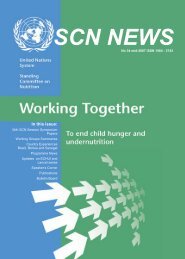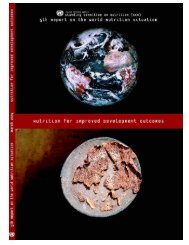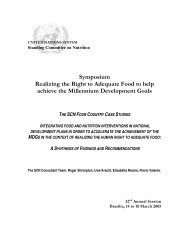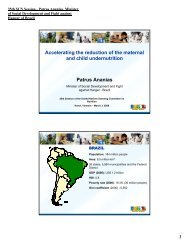Universal Salt Iodization (USI) - FTP Directory Listing
Universal Salt Iodization (USI) - FTP Directory Listing
Universal Salt Iodization (USI) - FTP Directory Listing
- No tags were found...
Create successful ePaper yourself
Turn your PDF publications into a flip-book with our unique Google optimized e-Paper software.
www.unsystem.org/scn FEATURES 51population and, if used as a target group, would dramatically increase the number of households that wouldneed to be visited in order to achieve a given sample size. In addition, the collection of urine specimens fromchildren less than 2 years of age in a cross-sectional survey would be difficult.Although palpation is useful in identifying moderate to severe levels of iodine deficiency, it is less useful insituations involving mild levels of iodine deficiency because of low sensitivity and specificity as well as a highinter-observer variation in distinguishing between grade 0 (no goitre) and grade 1 goitre (a palpable but notvisible goitre) (WHO/UNICEF/ICCIDD 2001). In addition, when the iodine nutrition status of a populationimproves, it may take years for most palpable goitres to return to normal size (Zhao et al 1999, Zimmermanet al 2003). These factors call into question the usefulness of palpation to assess changes in iodine statusover time (Gorstein et al 2001). Ultrasonography of the thyroid gland to estimate thyroid volume can provide arelatively precise measurement of thyroid size, but inter-observer variation has been high. A number ofthyroid volume reference curves have been published over the past 15 years (Sullivan et al 2005), andthyroid volume is also slow to change in an evolving iodine nutrition situation (Zhao et al 1999). Use of thyroidstimulating hormone (TSH) and thyroglobin (Tg) have been proposed as indicators of iodine status, but theirusefulness in determining iodine status from cross-sectional surveys has had variable results (Copeland et al2002, Sullivan et al 2005, Zimmermann et al 2006).Because of concerns about the usefulness of thyroid size and biological markers of thyroid function, crosssectionalsurveys should use urinary iodine levels as the primary indicator for assessing iodine nutritionstatus. Currently WHO has established optimal median casual urinary iodine levels of 100-199 µg/L forschool-age children and of 150-249 µg/L for pregnant women (Table 3). For school age children, there arealso criteria for the proportion with lower levels of urinary iodine (Table 1). What is not clear is whether it isacceptable to assess only school-age children, only pregnant women or whether both groups should beassessed. Because assessing pregnant women in a household-based survey is inefficient, an alternativestrategy would be to sample pregnant women from prenatal care clinics.While no international values exist for urinary iodine levels in non-pregnant/non-lactating women of childbearingage, some experts believe the same range for school-age children would be applicable (Delange2002). Another issue is that the urinary iodine status of school-age children may not reflect the urinary iodinestatus of women of childbearing age, pregnant and not pregnant (Copeland et al 2002, Caldwell et al 2005a).Consensus is needed on the appropriate target group(s) for assessing iodine nutrition status. In the mean-Table 3: Epidemiologic criteria for assessing iodine nutrition based on median urinary iodine concentrations in school-aged children,pregnant women, lactating women, and children less than 2 years of age.Source: For school-age children, WHO/UNICEF/ICCIDD (2001); for all others, ICCIDD (2007).Median urinary Iodine intakeIodine nutritioniodine (mg/l)School-aged children300 Excessive Risk of adverse health consequences (iodine-induced hyperthyroidism, autoimmunethyroid disease)Pregnant women500 ExcessiveLactating women and children less than 2 years old100 Adequateback to contents SCN NEWS # 35







